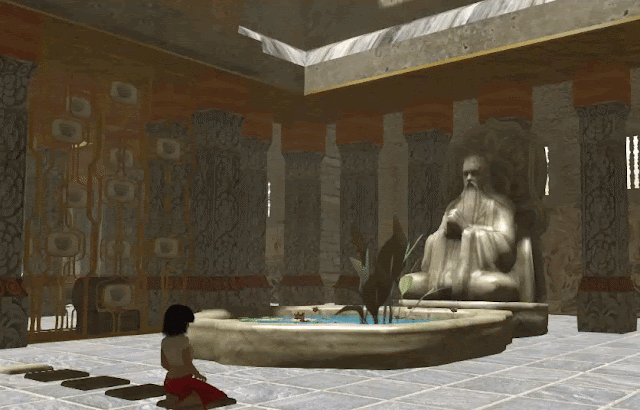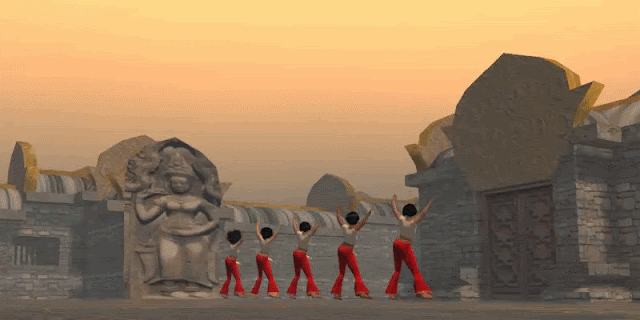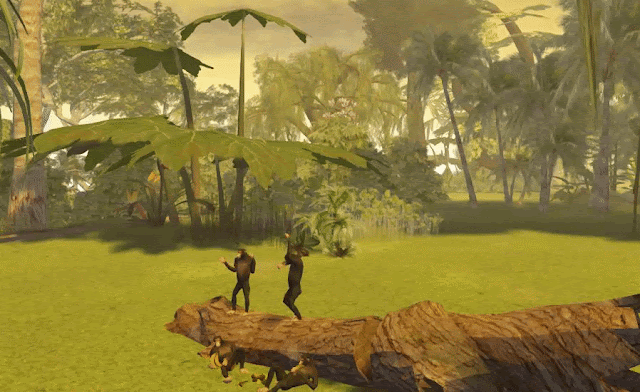It all happened in the 1100s, and only took a little over thirty years to complete. It's probably the world's largest sculpture, because the sandstone was all sourced, delivered by water cut to size, friction-fused, and only then carved and decorated by hundreds of talented sculptors skilled in bas-relief and monumental stone art.
Its principal courtyard could hold four Vatican Cities, the whole complex covers an area the size of Paris.
Its name is Angkor Wat.
If you're not up to taking the trip to Cambodia to see this precious symbol of Khmer culture, history, and religion, then sidle over to Craft Grid and you can see a fantastic recreation by renowned builder Tosha Tyran. The HG Address is, as ever, at the end of the post.
Tosha Tyran: Some years ago I casually saw a very fascinating movie on TV about Angkor Wat and right away I had the wish to do something about it in Virtual Worlds. I researched about it and grew fonder and fonder of that crazy idea...
_004.png)
Suryavarman II (his name in Sanskrit means 'he who is protected by sun') built this incredible religious complex - the name literally means 'royal city - temple', to express his immense power. Many in the past had built temples in the mountains. He decided to build a temple that was a mountain, a sort of image of himself as a representative and a personal iteration of the divine. Bringing it down to earth, it's a very square place, so it's easy to see why building it in a sim seemed so attractive.
_001.png) |
| Tosha's realistic boxy version of the temple complex |
The complex is made up of spaces for worship, courtyards, corridors, monumental buildings, but also domestic spaces to house at least 250 families. It was a hugely significant center for the Sanskrit ... empire is the wrong word, more of an agglomeration or sphere of influence.
The temple was built respecting the traditions of the Hindu religion, but it's located in a predominantly Buddhist part of the world so kind of bridges these two vastly influential religions.
In the RL Angkor, after passing over a causeway that takes you across the huge moat, you enter via relatively small, gloomy doorways that lead you into an immense floodlit space, and intricately carved galleries, full of devatas, Hindu legends and religious stories, but also scenes from daily life, a sort of stone snapshot of life a thousand years ago. In Tosha's version, the vast opensim ocean surrounds the build, but she has added some water features that capture the spirit of the place, and added some carvings to give a flavor of the richness of the interiors.
Tosha Tyran: The difficulties with textures in general is to find as many original fotos as possible that should meet the conditions to be used: - to be taken at the same light, the same angle, not twisted, good solution etc.
Thirza Ember: so in a way, your build is like a collage of many pictures?
Tosha Tyran: more than that - texturing a whole building means you have to use a lot of bits of photos to make a whole out of them. A typical mesh problem is to arrange a texture on a much bigger and more complicated piece than you would to with prims. Here's a little example: a simple table in prims would be 5 prims which you can texture individually and then match. The same table in mesh is one organic structure and to texture it, you have to keep that in mind, so the textures have the right size, the right direction etc. That can be a little hellish...
It is situated on a great fertile plain halfway between the Phnom Kulen hills and the Tonle Sap river. Due to the ebb and flow of the water levels during the dry and monsoon seasons, the Tonle Sap lake and river system changes direction several a year, making it a supernatural feature but t the same time an expression of man's ascendancy and skilled exploitation of the life giving water.
The idea that Angkor Wat was a 'lost' building is really only a colonial fantasy. In the 1500s there were like 150,000 people living in the area - more densely populated than London at the time. It first came to the attention of the West in 1860, when French naturalist and travel writer Henri Mouhot popped in to take a look. In a sort of Fake Frenchie News - 'we got lost treasures in our colonies' kind of way, the impression was given of ignorant locals and a building swallowed by the jungle.
 |
| Early drawing of the temple shortly after its 'discovery' |
If you want to know more about the land and its history, check out the fantastic blog by Alison in Cambodia, it's full of links to great sources, in video and text, that will enrich your understanding of this complex and ancient country.
Tosha Tyran: The most difficult part was to get an idea of the original structure of the build, as today it is practically totally in ruins and many parts of it overgrown by gigantic trees. But I found that there are different scientific team working on a reconstruction of the temple and the structures around it, so many ideas of what was the original structure is being conserved and also published.
The build comes to life with dozens of NPCs, expressing the liveliness of the place and also of course of Tosha's imagination - it is great to have these figures around to put the whole build in context.
Tosha has gone to a lot of trouble to also feature elements of everyday life as it's lived to day in this corner of the world, where tourism plays an enormously important part in the economy and cultural crosspollination of the country.
She has also captured to close relationship between the people and the landscape in terms of the sea - a relentles rival but also the provider of wealth and livelihoods, stories and legends.
... and of course, she couldn't neglect the wildlife!HG Address: To visit Angkor Wat in opensim, go to craft-world.org:8002:Angkor Wat

.png)

_003.png)
.png)
_002.png)
.png)
.png)

_005.png)


Thanks, Thirza! What a fantastic comment on the region. And I just love those fotos!
ReplyDelete